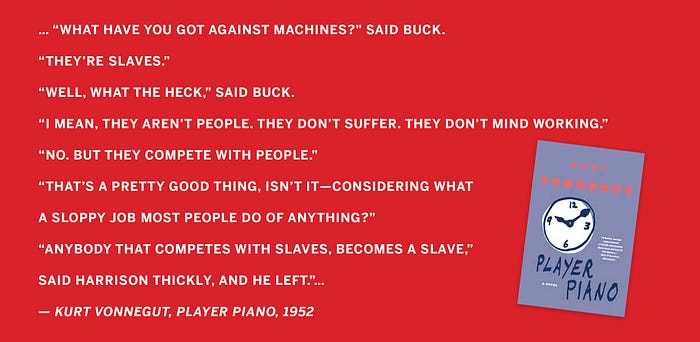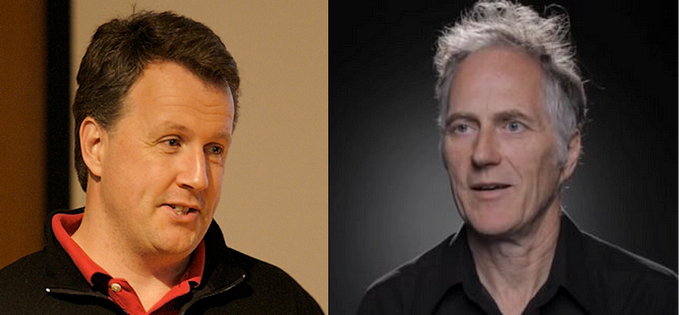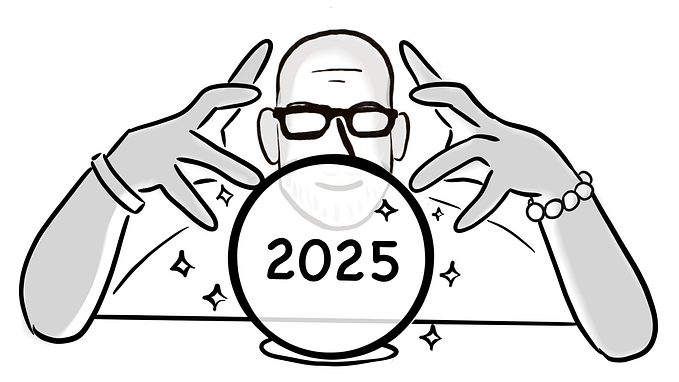Being Human in the Age of AI, Robotics & Big Data
(reprinted from the KINpendium, a publication of the Kellogg Innovation Network, KIN Global 2016 conference)

According to a recently published report by industry analyst Forrester, six percent all US jobs will be replaced by automation over the next five years. Ten years from now, despite their rosy prediction of a 9% increase in the number of jobs, 16% of all jobs will be automated, resulting in a 7% net loss for human workers.
Described as “a disruptive tidal wave,” the transformation will mostly impact transportation, logistics and customer service sectors — sectors that have tentacles into almost everything we do. From autonomous vehicles (cars, trucks, drones), to personal assistants (Apple’s Siri, Microsoft’s Cortana, Google’s Assistant and Amazon’s Alexa), to armies of unflappably cheerful customer service “chatbots,” our daily lives are increasingly shaped by and, indeed, made possible by digital algorithms. We literally live by the code.
Tech, of course, is neither good nor evil, but rather effective or in some way deficient. It can be used to benefit a fortunate few, elevate the many, or lead to extraordinary vulnerability. Drones, for example, can be programmed to transport medical supplies, survey farm fields, surveille enemies, surveille us or drop bombs. And while sensor-enhanced “smart” appliances and systems add functionality, they also provide hackers with new entry points for all sorts of cyber mischief.
The line between techno-fiction and techno-fact has become vanishingly thin. “Our Democracy Has Been Hacked,” according to television cult favorite Mr. Robot. In real life (aka “IRL”), Russian hackers have, in fact, attacked voter registration databases in two states, including the theft of an estimated 200,000 voter records in Illinois. As a resident of Illinois, mine may be among them, instantly turning an abstract threat into one deeply personal and unnervingly specific: Will a Russian algorithm steal my American vote come November?
BIOMIMICKED BRAINS + ROBOTIC BRAWN
Artificial Intelligence (AI) — perhaps more accurately described as synthetic since the intelligence is quite real — truly is something new under the sun. The combination of biomimicked brain and robotic brawn has already extended human capabilities into the realm of superhuman. Not only can we now see to the edges of the universe, to the very the beginnings of time itself, but the race is on to build ships that will soon make space travel as ho-hum as plane travel. (Millions of us take to the air on an estimated 100,000+ flights each day — something inconceivable just a century ago — so it really doesn’t seem that far-fetched.) The list of potential “Goldilocks” planets, the ones not too big, not too small, not too poisonous, just the right distance from a sun, with water, plate tectonics and an atmospheric shell to protect against whatever the cosmic winds might bring — a place where life in some form or another just might exist — grows almost by the day. For most of human history, we were certain of our solitude in the universe. We may still be alone, but the odds are shifting.
In the blink of a decade, bionic body parts 3D-printed from inks made of living cells or from materials that algorithms helped design have gone from drawing board to proof-of-concept. Product design of every kind has transformed into a computer-enhanced “generative” process where countless options are virtually prototyped and instantly tested. Layer by thinly-printed layer, designers are reimagining everything from sports shows to buildings, creating forms that are lighter, more aerodynamic, more ergonomic, more efficient and stronger than anything ever before.
Networks of computers spread across the world collectively hum with calculations, busy creating distributed ledgers known as blockchains. These can be configured to facilitate financial transactions without need of banks and legal agreements without need of lawyers. The “trustless trust” borne out of unblinking, tireless algorithmic accuracy may soon replace legions of government bureaucrats, processing everything from medical records to real estate transactions. Yet while an algorithm cannot be bribed, it can still be hacked. For better and worse — and the dramatic heart of countless sci-fi stories — those unruly humans are still a problem.
Perhaps that will change as computer code untangles our code: DNA. Now life itself can be designed and with tools such as CRISPR, in ways both breathtakingly precise and evolutionarily game-changing. Nature still has a way of batting last, so the jury is out on whether its laws truly can be circumvented or only diverted, but clearly rules are being bent at every turn. Two parent babies are so 20th century. Why not have one with three parents…or more?
Human evolution, however, is a matter of culture as well as biology, notes David Krakauer, president of Santa Fe Institute. In terms of biology, humans are just another branch on the Tree of Life. What set us apart was the emergence of civilizations, beginning in earnest roughly 5,000 years ago that left a trail of “cognitive artifacts” — Krakauer’s term — in their wake. They come in two varieties: Complementary cognitive artifacts extend human abilities to reason about the world, amplifying what we are able to do. For example, studying a map provides a spacial awareness that remains in memory even after the map has been put away.
Competitive cognitive artifacts, on the other hand, are analogs of what we do, with capabilities that generally surpass our own. A computer program that translates GPS coordinates into a series of audio instructions delivered via smart phone perched on car seat is undeniably helpful, but provides no spacial awareness. If the cell signal were to be lost, so, too, would the driver. Competitive artifacts create dependency.
AI falls into the second category: Deep Learning systems layered with neural nets are designed to learn how to learn and thus may be the ultimate competitive cognitive artifact. In the relatively low stakes arena of games,IBM’s Watson has already bested the human best at Jeopardy, while Google’s AlphaGo has taken the trophy for Go. “The golden rule of cognition and evolution is use it or lose it,” notes Krakauer, so our future depends on how this plays out.
REALITIES, SENSORS & DATA
Reality itself has reached a new existential plateau: When algorithmically-ordered virtual worlds can feel as real as the physical world — when bits are experienced as atoms — what is reality?
Already, much of what we experience has been shaped by invisible digital hands, creating subtle feedback loops shaping what we think and who we are. From search engine “filter bubbles” to social media newsfeeds, algorithms have been programmed to match would-be consumers with the would-be consumed. Stories and posts are ranked by advertiser-enticing metrics of popularity and tallies of clicks. Increasingly, the content itself is being written by algorithmic scribes fluent in “natural language.”
Connecting the real world to the cyber are small sensor-laden beacons that can be embedded almost anywhere imaginable, from store shelves to street lamps. They track trails of invisible “digital exhaust” — cell phone “pings” — and bit by itty bit our digital dossiers grow. That well-timed coupon in your inbox? It might be serendipity or it could be calculated kismet. That’s the good scenario.
The infrastructure of what futurist and designer Mickey McManus calls the “the trillion node network,” was laid decades ago when microprocessors began replacing mechanical components in consumer products. It was a shift driven by simple economics: designing software as one-time expense is cheaper than designing, then fabricating physical parts calculated as per unit costs.
Today, there are more microprocessors — tiny computers — produced in a year than there are people on the planet. Now, ever-tinier sensors embedded in everything we touch and see connect en masse to the Internet, animated by — and animating — algorithms grown ever more powerful on endless feasts of data.
BEING HUMAN
So what does it mean to be human when machines can do, or soon will be able to do, almost everything better than we can?
It means we have powers at our fingertips — literally at our verbal command — that would have seemed magical just a few years, a few months, or even a few minutes ago. Our ancestors, clever though they clearly were (see cuneiform tablets, says Krakauer), would have been just as astonished as their modern descendants by Alexa, Amazon’s increasingly ubiquitous digital assistant when she/it was introduced last year. Simply say, “Alexa! Order a box of Boffo-riffic laundry detergent!” and an internet-enabled cylinder called an Echo, small enough to tuck into a corner of a counter top, orders a box of Boffo-riffic — or almost anything else — to be delivered to your door; and soon, by drone. (Why, though, are so many digital assistants given women’s names and voices? Where are Alex, Sir and Cortan to do my bidding?)
As for the smart phone — soon to celebrate its first decade — its least interesting feature is being a phone. Like Tom Waits’ classic ode to the dazzling pitches of infomercials past (Step Right Up!), there is almost nothing a smart phone cannot do. It is a flashlight, a compass, a clock, a level (complete with “floating” bubble), a camera, an audio recorder, an editing suite, a video-podcast-radio player, a magazine stand, a book store, a wallet. It may not walk the dog, but it can keep track of him. It is an ever-slimmer, increasingly powerful, web-connected computer. And soon, with the battle for “smart home” control in high gear, it will be literal keys to the kingdom, too.
To be human today means being able to do things we have always done more easily; and to do things that simply weren’t possible before:
- Print a building!
- Post a blog or a photo or a video that can be read by almost anyone, anywhere, at any time!
- Flatten time and space in a keystroke, and collaborate with colleagues across the world in an instant.
- Watch a Harvest moon rise over Lake Michigan while keeping moment-by-moment tabs via smart phone on its direction, altitude and distance.
•••••••••••••••••••
For all the cyber dazzle, though, there is a point where technological prowess gives way to something that defies programming, says Robert Wolcott, KIN co-founder and executive director. The desire, the need to create, he notes in the conference’s concluding session, might be humanity’s defining trait.
Thus it has always been. Images painted in caves and on rocks all over the world tens of thousands of years ago still resonate in a profoundly powerful, uniquely human way. Beyond the similarity of an ancient’s handprint to our own, or the recognition of an animal, there is a synaptic connection that arcs across time, speaking to the irrepressible urge to make marks, record impressions, communicate and create art. Perhaps these works were primers for hunting or a way to confer with deities. We will never know the details, yet instinctively understand the deepest “why” of why they were made.
Today, we collectively share photographs by the billions on social media. Hundreds of hours of videos are uploaded to YouTube each minute. We post stories, compose music, paint and sculpt. We tinker and invent. “We are all makers,” says resident Maker Faire Pied Piper and KINian Dale Dougherty. Simple as that.
•••••••••••••••••••
By contrast, even as algorithms edge ever-closer to creating sonnets so human-like that human judges are convinced they were written by a some-one and not a some-it, computers have only a limited, technical understanding of the words generated. Clever Alexa hasn’t a clue what she/it is saying, though programmed to respond to specific requests (and soon, start conversations, too).
No computer has yet on its own felt a need to create. For now at least, androids don’t dream of electric sheep. They don’t dream at all.
•••••••••••••••••••
Boundaries of every sort are shifting as they have never shifted before. Digital information sails over / through / beyond geopolitical walls (and would-be walls), while polar glaciers melt at record rate and rising sea levels redraw maps.
To be human today means living in a world where almost every day brings some sort of disturbing record: The hottest, wettest, driest stretch of weather. The fiercest wildfires, tornadoes, typhoons. Atmospheric carbon levels near the point of climate no-return. Acidifying oceans. Exotic diseases. Antibiotic-resistant superbugs.
All of this is happening as the human population explodes, more than doubling to 7.4 billion in just the last half-century — not even a blink in planetary time. Today, more people live in cities than lived on the entire planet in 1960. Yet — and not unrelated — we are in the midst of the Sixth Great Extinction: Our fellow travelers on Earth’s ark are dying off at alarmingly accelerated rates.
To be human today means leveraging our new technologically-enhanced superpowers to find solutions to stave off catastrophe. A fortunate few may be able to travel to other planets soon, but as a species, we will never find a planet as perfectly suited for us as what Carl Sagan famously called a pale blue dot. Earth is not just our natal planet. It made us possible.
It will take a partnership of intelligences — human and synthetic — to find ways not only to repair the damage, but to forge a more promising and secure future for all. It will take robots doing the heavy lifting and the development of new categories of jobs better suited for people. While the Forrester report presents a bleak picture in the near term for human job prospects, there may be “unknown unknowns.” Predictions based on best-guess assumptions are always subject to change. The automobile put horse farriers out of business, but created jobs for mechanics and parts manufacturers.
It will take the best of the human algorithm — imagination, creativity, resourcefulness, a belief in the greater good, a sense of fairness and empathy — to get to that better future.
Even that doesn’t guarantee success. KINian Sian Hansen, Executive Director of the London-based Legatum Institute, oversees the Institute’s annual Prosperity Index, which analyzes and compares 142 countries across eight categories and 89 variables. Will the future be more Norway or North Korea? The human algorithm also includes greed, corruption, ignorance and cruelty. The machines will do whatever they are programmed to do. The responsibility of what that is and what happens next still remains in our collective human hands.
••••••••••••••••••
Nearly 65 years ago, Kurt Vonnegut’s novel Player Piano was published, painting a picture of a post-war dystopian future where the machines have replaced workers and society has become stratified. At the top are well-paid engineers who invent new machines to replace more workers and tend to whatever small mechanical glitches arise. At the bottom are replaced workers, who have been given jobs at the Reconstruction and Reclamation Corps (“Reeks and Wrecks”) with a small salary as a kind of basic income. Their real purpose to consume whatever the main computer’s algorithm has decided must be consumed to keep the economy humming. Although the tech is vacuum tubes and the storytelling both relentlessly sexist and blithely racist, it is deflating to realize just how predictable our cutting-edge present seems to have been. There are smart homes and AI, hackers and drones. There is also an uprising…
The player piano, designed to reproduce the experience of a live performance without the actual presence of a performer, is an apt metaphor. The mechanized instrument transforms it from a tool that allows us to make musics (in Krakauer’s terms, a complementary cognitive artifact that extends our abilities) into a competitive cognitive artifact that replaces us. Who needs to know how to play the piano when the piano can play itself?
Robert Wolcott for one, who ended the KIN conference with a performance of an original piano composition. He did what no computer has ever done, what no algorithm, at least so far, has ever been programmed to do: create art because he wanted to, was inspired to, because it felt good to do. The video recording of the concert (embedded top right) allows us to witness the “alive-ness” of the performance. Speaking as one who was there, however, it preserves only one slice of the experience. It cannot capture how it felt to be in the concert hall with a connection to the music, to Wolcott and to the audience as a whole. Like the KIN’s one-performance-only Etudes of Innovation series, the ephemeral immediacy itself is powerful, binding us to our history — and biology — as humans.
Close your eyes and imagine other concerts from long ago that took place in caves and around decorated rocks. We are the future our ancestors could never have imagined. Who — or what — will be ours?
This is a pivotal moment. With the extraordinary technological tools now at our disposal, the damage our species has done wittingly and otherwise to our planet over the last few hundred years can be remedied. We have the means to steady a fast-changing climate and improve the lives of the many, not just the “one percent.” If we do not do what can be done, we risk losing it all and then, who knows? Perhaps, Matrix-like, the bots will inherit the Earth.
Our path requires us to draw on the best of our humanity: the inspiration to create, the drive to make — and make things better — and the generosity to share, one original, inspired note at a time.
RELATED
RELATED
• Prometheus Redux | Robert C. Wolcott | transcript | pdf
• Player Piano | Kurt Vonnegut | book
• Why Deep Learning is Suddenly Changing Your Life | Fortune | Roger Parloff | article
• Robots, AI Will Replace 7% of all US Jobs by 2025 | Forrester | research report press release
• Chatbots and chat interfaces: Fad or the next big thing in tech? | The Next Web | Martin Bryant | article
• Siri answers your questions. This bot will understand your emotions. | Washington Post | Steven Overly | article
• Why chatbots suit India better than apps | Tech in Asia |Meghna Rao | article
• WTF: What’s the Future of Work? |curated by Tim O’Reilly | blog
• Highlights from the O’Reilly AI Conference in New York 2016 | article & video links
• Yahoo’s Titanic Data Breach Highlights Risk to M&A |Robert Hackett | Fortune |article
• The UAE Drones for Good Award | competition | website
• Dad, son fight FAA over gun-firing, flame-throwing drones | CBS | article & video
• Fuel cells set to power up the drone industry | CBC | Marcel Sangsari | article
• What if the Aliens We Are Looking for are AI?| BBC | Richard Hollingham | article
• How we trained AI to be sexist | engadget |Kerry Davis | article
• Artificial Intelligence | Elsevier | journal
• This Investing Robot Could Juice Your Returns by 15% | Bloomberg | Suzanne Woolley | article
• SpaceX And Blue Origin Fight To Win The Modern Space Race | Fast Company | Austin Carr | article
• Doctors 3D-print ‘living’ body parts | BBC | Jame Gallagher | article
• Generative Design: software mimics nature’s approach to design | Autodesk |video & article
• Mediated Matter Lab | MIT Media Lab | website
• 3D Printing Is Already Changing Health Care | HBR | Drew Hendricks | article
• Contour Crafting | Robotic Construction System | website
• Dubai debuts world’s first fully 3D-printed building | Inhabitat |Cat DiStasio | article
• Lawmakers announce blockchain technology caucus | The Hill | Ali Breland | article
• KIN Talk on Blockchain | John Clippinger | bio & video
• CRISPR: gene editing is just the beginning | Nature | Heidi Ledford | article
• The Crispr Quandary | New York Times Magazine | Jennifer Khan | article
• Experts warn home ‘gene editing’ kits pose risk to society | The Guardian | Ian Sample | article
• Opposed to GMOs? Are Monsanto’s new CRISPR crops any better? | Digital Trends | Lulu Chang
• KIN Talk on Cognitive Artifacts | David Krakauer | bio & video
• Primordial: When Things Wake Up | O’Reilly Solid conference | Mickey McManus | video
• KIN on Virtual Reality | article & videos
• Human Or Machine: Can You Tell Who Wrote These Poems? | NPR |article & audio
• AI’s Language Problem | MIT Technology Review | Will Knight
• Do Androids Dream of Electric Sheep? | Philip K. Dick | book











